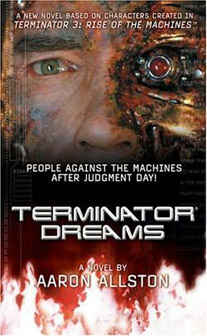After six novels that had good points worth picking out but weren’t consistently great, Aaron Allston delivers the first rock-solid page-turner of the franchise with “Terminator Dreams” (2003), which functions as a prequel and sequel to “Terminator 3.”
Allston works hard at making continuity connections to the movies, but a close look shows that he contradicts the “T3” novelization enough times (as noted below) that one could make a case that “Terminator Dreams” is on a separate timeline. However, his concept of “microparadoxes” might allow us to say this is the same “T3” timeline, only with slight adjustments by the gods of time.
Still, it’s refreshing to have Allston – whose “Star Wars: X-Wing” novels I admire – as a writer in the “Terminator”-verse, even if he doesn’t spend a lot of time on the movie characters. He’d return a year later with the only other “T3” novel, “Terminator Hunt.”
CHARACTERS
John Connor: John is “50-plus” in August 2029 (p. 15), meaning that on this timeline, he was born in 1978 at the earliest. This contradicts not only the primary “Terminator” timeline, in which he was born in 1984, but also the “Terminator 3” timeline, in which he was born in 1980 or ’81.
Sarah Connor: She’s not alive in either the “present day” (2004) or 2029 portions of the book, as the “T3” movie had established she had died after “T2.”
Kyle Reese: He’s dead in the 2004 portion of the book, as per the events of “T1,” and the 2029 portion of the book takes place after he had been sent back in time (to 1980, since we’re talking about the “T3” timeline) via the Continuum Transporter. He had trained with the Hell Hounds (p. 153), meaning he had met his granddaughter, Kyla, without knowing it.
Kate (Brewster) Connor: John’s wife and second-in-command, as established in “T3.”
Kyla Connor: John and Kate’s daughter, she is “not quite out of her teens” (p. 20) in 2029. She is a member of the Hell Hounds, one of John’s top squadrons, and presumably named after her grandfather, Kyle Reese.
Danny/Daniel Avila: The book’s main character, we meet him in both 2004, when he’s developing Terminator programming for Cyber Research Systems (Autonomous Weapons Division) at Edwards Air Force Base, and in 2029, when he’s a techie for the Resistance. Via the “dreams” of the title, he can mind-hop between his younger (Danny) and older (Daniel) selves.
Michaela “Mike” Linda Herrera Avila: Danny’s lover, she is no doubt named after both of the lead actors in “T1.” Along with Danny, she is part of the reprogramming and Continuum Transporter team.
Mark Herrera: Danny and Mike’s son, he is also able to reprogram Terminators.
Crazy Pete: This Resistance soldier doesn’t play a major role in the novel, but it’s worth noting that John had “known Crazy Pete even before Judgment Day” (p. 171), although this character is not referenced in any previous stories.
TERMINATORS
Scowl: Danny’s prototype design, he’s a “second-generation Terminator” (p. 294). He rolls on treads like the T-1s from “T3,” but he has an endoskeleton-style face and armature that’s able to grasp weapons like traditional endos. He doesn’t have voice-recognition ability nor the ability to speak, but he can drive a vehicle.

T-800s: John’s group is attacked by a T-800 — of the Sergeant Candy (Arnold) 101 model — in August 2029. Kate observes that “they haven’t scrapped the last of the T-800s after all.” In the “T3” novelization, Kate sees a pile of discarded T-800s and T-1000s in July 2029, a sign that Skynet is moving toward deploying only T-Xs. In 2004, T-800s are on the drawing board, as we also saw in a deleted scene in “T3.”
T-1s, T-1-5s and T-1-7s: These are among the models Danny had worked on (p. 90). The T-1s (essentially mini-tanks) are seen in the Edwards Air Force Base attack in “T3.”
T-Xs: This model – made famous in “T3” — doesn’t appear in this book, although the Resistance is aware of them as of August 2029 (p. 132).
Endoskeletons: Allston sometimes calls them “Skynet assault troops.”
CONTINUITY AND CONTRADICTIONS
“Terminator Dreams’ ” “T3” prequel scenes take place in July 2004, leading up to Judgment Day, and the Future War scenes take place in August 2029, after all the Continuum Transporter time travel missions have been taken care of (something that contradicts the “T3” novelization, as I’ll explain in the Time Travel and Timelines section).
The Resistance on this timeline sprang in large part from the U.S. Armed Forces (p. 22). It uses a lot of the same terminology for ranks and organization. This is consistent with what we saw in “T3,” where the Resistance raises a U.S. flag to mark a victory in the Future War.
John’s permanent Future War base is Home Plate, in Beverly Hills (p. 63). Previous stories had been vague about whether John maintains a permanent base, although the setting in the Los Angeles metro area is common.
Daniel Avila had reprogrammed the “T2” T-800 (p. 82) on the “Terminator 3” timeline. Interestingly, the similarly named Danny Dyson is the Terminator programming expert in the “Terminator 2” timeline of the Malibu Comics and Blackford novels, although it is unknown if Allston was making an homage to that character.
Daniel is not mentioned in “T3” or its novelization, where a man named Tony Flickinger is said to be the genius behind Skynet.
Daniel’s bizarre ability to mind-hop is largely a “just go with it” concept, although Allston makes a fair stab at explaining it by noting that Danny worked in proximity to the particle accelerator at Edwards (as seen in “T3,” it’s the device that the T-X temporarily gets glued to). Kate has a less extreme version of Danny’s ability, and she also spent time at Edwards, hence the theory. In the “T3” novelization, present-day Kate has dreams of the future.
Skynet creates the computer virus so the military will then empower it to eradicate the virus (p. 204), thus giving it the autonomy needed to launch the nukes. This concept is present in “T3,” but Allston explains it more clearly.
John reminisces about what he was doing the day before J-Day (meeting Kate at the animal shelter) as Daniel is experiencing the same day through his connection with his younger self (p. 291).
At the book’s end, Daniel goes back in his mind to April 2004 – two months before the mind-connection chronicled through most of the novel – and adds more programming to the Terminator code (p. 340). This programming gives Terminators the learning and empathic abilities that will allow the T-800 and T-850 to form friendships with John in “T2” and “T3.”
TIMELINES AND TIME TRAVEL
The Continuum Transporter is being designed by humans at Edwards AFB (p. 104). Humans also developed the time-travel device in the Blackford novels, although in that case it was with help from the future. In most previous yarns, the time-travel device was designed by Skynet for the purpose of bringing the war to the past.
Kyle was sent back “earlier this year” (p. 81) relative to August 2029, but unlike in most other stories about this event (including the first one, “All My Future’s Past,” on the “T1” timeline), the Continuum Transporter is not destroyed in the aftermath of Kyle’s transportation. This is not a contradiction, as the “T3” franchise is on a substantially different timeline from “T1” and “T2,” and the reason for Skynet not destroying the CT is explained by Allston: In a nutshell, Future Danny instructs Past Danny to instruct Skynet to not destroy it.
In addition to the CT not being destroyed, another major difference from the “T1” and “T2” timelines is that the act of sending the time travelers back is not followed by the Resistance’s smashing the defense grid and winning the war. In “Terminator Dreams” – as with the “T3” novelization — the war simply continues apace.
By August 2029, John had used the Continuum Transporter three times (p. 84) and Mike was on the mission to help reprogram the T-800 and T-850 (p. 161). These references contradict the “T3” novelization, where the T-850 was sent back from 2032 (in pursuit of the T-X, which was sent back from 2029 in the “T3” novelization but from 2031 in the “T3” Beckett comics).
But maybe there’s a way to explain the T-850 (and the T-X, for that matter) being sent back in two different years, albeit a tenuous and vague one: Allston relies on the concept of “microparadoxes” as Daniel and other characters from 2029 manipulate events in 2004 via Danny Avila’s brain. Essentially, small changes are allowed within a timeline without a separate timeline branching off of it. Although Mike posits both the overwriting and branching theories of time manipulation, John believes history adjusts (p. 83) and people’s memories adjust accordingly without them being aware of it. Dark Horse’s “Endgame” and “Robocop versus Terminator” comics from the “T1” timeline operate under this overwriting theory, as does the “T2” novel “Hour of the Wolf.” However, the concept of people “winking out of existence,” as 2029 Daniel fears will happen if 2004 Danny dies (p. 281), isn’t off the table. The characters are in the same boat as the readers in that they don’t know the rules of time travel, and Allston – as with most authors in the franchise – doesn’t serve as an all-knowing narrator.

